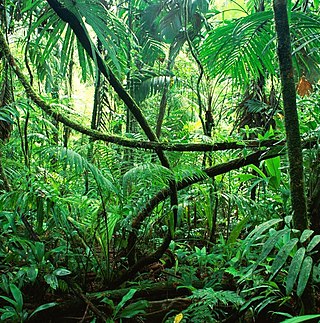
Rainforests are forests characterized by a closed and continuous tree canopy, moisture-dependent vegetation, the presence of epiphytes and lianas and the absence of wildfire. Rainforests can be generally classified as tropical rainforests or temperate rainforests, but other types have been described.

Ficus macrophylla, commonly known as the Moreton Bay fig or Australian banyan, is a large evergreen banyan tree of the Mulberry Family (Moraceae) native to eastern Australia, from the Wide Bay–Burnett region in the north to the Illawarra in New South Wales, as well as Lord Howe Island where the subspecies F. m. columnaris is a banyan form covering 2.5 acres or more of ground. Its common name is derived from Moreton Bay in Queensland, Australia. It is best known for its imposing buttress roots.

Temperate rainforests are rainforests with coniferous or broadleaf forests that occur in the temperate zone and receive heavy rain.
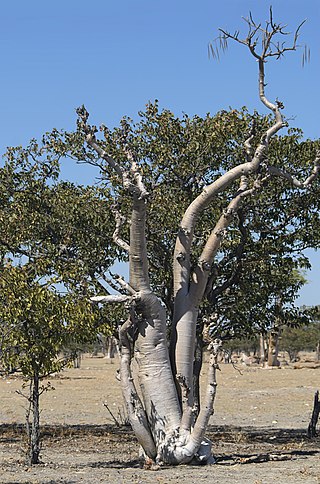
Moringa is the sole genus in the plant family Moringaceae. It contains 13 species, which occur in tropical and subtropical regions of Africa and Asia and that range in size from tiny herbs to massive trees. Moringa species grow quickly in many types of environments.

The Daintree Rainforest, also known as the Daintree, is a region on the northeastern coast of Queensland, Australia, about 105 km (65 mi), by road, north of the city of Cairns. Whilst the terms "Daintree Rainforest" and "the Daintree" are not officially defined, it is generally accepted and understood that they refer to the area from the Daintree River north to Cooktown, and from the coastline west to the Great Dividing Range. The popular tourist destination of Mossman Gorge, some 30 km (19 mi) south of the Daintree River, is often included in the definition.
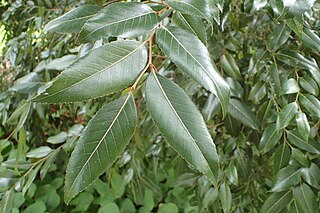
Nothofagus moorei, commonly known as Antarctic beech, is an important Gondwana relict of the rainforests of the southern hemisphere. It occurs in wet, fire-free areas at high altitude in eastern Australia.

Grevillea robusta, commonly known as the southern silky oak, silk oak or silky oak, silver oak or Australian silver oak, is a flowering plant in the family Proteaceae, and accordingly unrelated to true oaks, family Fagaceae. Grevillea robusta is a tree, and is the largest species in its genus. It is a native of eastern coastal Australia, growing in riverine, subtropical and dry rainforest environments.

Cupaniopsis is a genus of about 67 species of trees and shrubs of the soapberry family, Sapindaceae. They grow naturally in New Guinea, New Caledonia, Australia, Torres Strait Islands, Fiji, Samoa, Sulawesi, Micronesia. Many species have been threatened with extinction globally or nationally, with official recognition by the International Union for Conservation of Nature (IUCN) and several national and state governments.
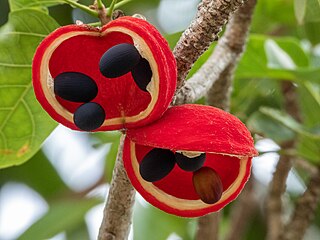
Sterculia quadrifida, also known as the peanut tree, monkey nut or red-fruited kurrajong is a small tree that grows in the rainforests, vine thickets, and gallery forests of New Guinea and northern Australia.

Dendrocnide moroides, commonly known in Australia as the stinging tree, stinging bush, or gympie-gympie, is a plant in the nettle family Urticaceae found in rainforest areas of Malesia and Australia. It is notorious for its extremely painful and long-lasting sting. Indeed, it is sometimes referred to as the suicide plant because its sting is so misery-inducing that it has been said to cause suicides. The common name gympie-gympie comes from the language of the indigenous Gubbi Gubbi people of south-eastern Queensland.

Semecarpus australiensis, commonly known as the tar tree, native cashew, marking nut, or cedar plum, is a species of tree in the cashew, sumac and mango family Anacardiaceae, native to parts of Melanesia and northern Australia. Contact with the plant can cause serious allergic reactions, a common characteristic of this family.

Meiogyne is a genus of flowering plants with 38 species belonging to the family Annonaceae. It is native from southwestern India and Indochina to Australia, including Fiji and New Caledonia. The type species is Meiogyne virgata.

Alexander Geoffrey Floyd was an Australian botanist with an expert knowledge of rainforest plants, particularly the rainforest trees of New South Wales. He has worked with the New South Wales Forestry Commission, the Department of Forestry in Papua-New Guinea, and the National Parks and Wildlife Service of New South Wales. He helped create the North Coast Regional Botanic Garden at Coffs Harbour. Two genera and several species of plants are named in his honour; including Floydia, Alexfloydia, and Endiandra floydii.

Cupaniopsis anacardioides, with common names tuckeroo, carrotwood, beach tamarind and green-leaved tamarind, is a species of flowering tree in the soapberry family, Sapindaceae, that is native to eastern and northern Australia. The usual habitat is littoral rainforest on sand or near estuaries. The range of natural distribution is from Seven Mile Beach, New South Wales to Queensland, northern Australia and New Guinea.

Mount Banda Banda, a mountain of the Mid North Coast region of New South Wales, Australia, is situated 320 kilometres (200 mi) from Sydney within the Willi Willi National Park. Banda Banda can be seen on the north-western horizon from Port Macquarie, as well as on the south-western horizon 39 km from the town of Kempsey. At 1,258 metres (4,127 ft) AHD it is the highest mountain in the region.

The Boorganna Nature Reserve is a protected nature reserve located northwest of Taree on the Comboyne Plateau in New South Wales, Australia. The 396-hectare (980-acre) reserve, managed by the NSW National Parks & Wildlife Service, was gazetted in 1904 and is the second oldest nature reserve in the state. The reserve features various forest types, including stands of sub tropical rainforest of which the large rosewood, yellow carabeen and small leaf fig are particularly noteworthy. The reserve is a remnant of the former extensive rainforest on the Comboyne Plateau. The plateau was cleared between 1900 and 1925. Australian red cedar was logged in the area in the nineteenth century. Originally proposed to be part of the world heritage rainforest group. The exploration, knowledge, uses and history of this area by Indigenous Australians is not well known in the present day. Boorganna Nature Reserve was proposed, but rejected for inclusion on the UNESCO World Heritage, due to being geographically isolated from other rainforests in the group.

Numinbah Nature Reserve is a protected nature reserve that is located in the Northern Rivers region of New South Wales, in eastern Australia. The reserve was gazetted in December 1981 with a further addition made in 1989 to make the reserve to its current area of 858 hectares. The reserve is situated north-east of the rural locality of Numinbah, and south of the Queensland town of Springbrook and defines part of the state border between New South Wales and Queensland.

Moringa stenopetala, commonly known as the African Moringa or cabbage tree, is a deciduous tree in the plant genus Moringa, native to Kenya and Ethiopia. A drought-resistant species, it is characterized by its bottle-shaped trunk, long twisted seed pods, and edible leaves likened to cabbage, from which its common name is derived. M. stenopetala is extirpated in the wild in Ethiopia, though still grown there as a crop on the terraces of the Ethiopian Highlands, mainly in the Konso region.
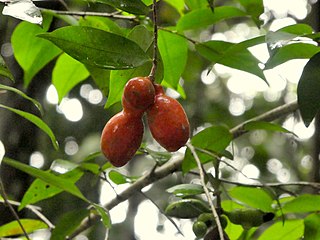
Meiogyne cylindrocarpa, commonly known as fingersop or native apricot in Australia, is a small tree or shrub in the custard apple family Annonaceae, native to parts of tropical Asia and Australasia.

Meiogyne hirsuta is a plant in the family Annonaceae endemic to the Wet Tropics of Queensland in Australia. It is known from only a small number of collections from three widely separated locations in the Wet Tropics, namely Cedar Bay near Cooktown, the lower reaches of Mossman Gorge, and the foothills of the southern Atherton Tablelands in the vicinity of the North Johnstone River.




















